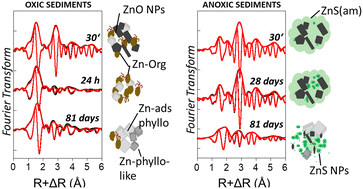Transformation of zinc oxide nanoparticles in freshwater sediments under oxic and anoxic conditions†
Abstract
The transformation of zinc oxide nanoparticles (ZnO NPs) has been largely investigated in wastewater treatment plants, recognized as important intermediates before the discharge of NPs into the environment. However, considering direct releases of the pristine ZnO NP forms, additional studies on ZnO NP fate in different environmental compartments are encouraged. In this work, we investigated ZnO NP transformation in lacustrine sediments under defined redox conditions. Using X-ray absorption spectroscopy and wet chemical analyses, we followed ZnO NP and Zn2+ fate over a three-month period in sediments incubated under oxic or anoxic sulfide-rich conditions. Under oxic conditions, ZnO NPs were dissolved within a few hours. By contrast, ZnO NP dissolution under anoxic conditions was much slower, with ∼19% of ZnO NPs remaining at the end of the incubation, together with ∼41% of ZnS, ∼15% of Zn adsorbed onto phyllosilicates and ∼27% of Zn-phyllosilicate-like species. The transient formation of Zn–organic complexes under oxic conditions supports that ZnO NP dissolution is driven by organic compounds, followed by Zn adsorption onto phyllosilicates and the subsequent formation of Zn-layered minerals. Under anoxic conditions, ZnO NP dissolution is inhibited by the precipitation of amorphous ZnS and controlled by the progressive growth of ZnS NPs. These results improve the understanding of ZnO NP transformation in slightly alkaline freshwater sediments and highlight the need to assess NP fate under environmentally relevant conditions.

- This article is part of the themed collection: Environmental fate of nanomaterials


 Please wait while we load your content...
Please wait while we load your content...